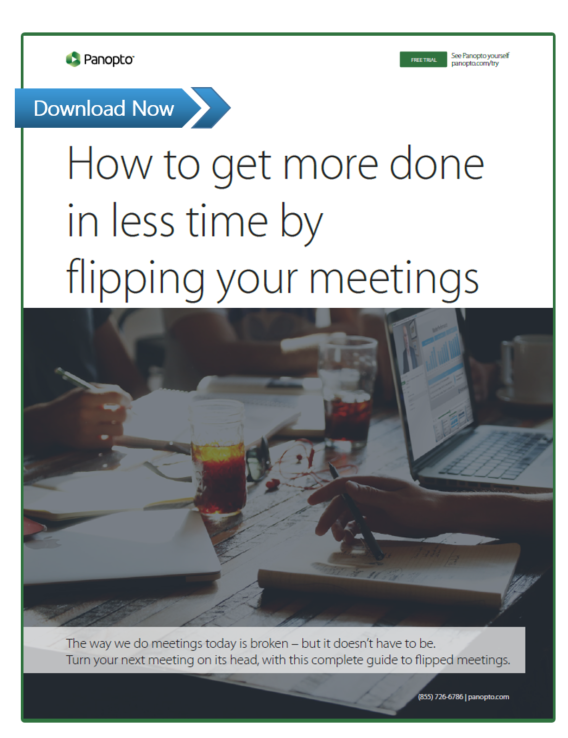- Collaboration
Make Meetings More Interactive Simply By Changing The Format

There are too many presentations being made in today’s meetings.
That’s not something we say lightly — we make video software for recording and sharing online presentations, after all.
The Harvard Business Review has spent the summer looking into the question of whether meetings should prioritize presentations or conversations. The HBR team quite reasonably doesn’t call for an outright ban on either style, but does repeatedly note that most organizations over-rely on presentations as meeting drivers, and as such, often miss out on more productive conversations.
 Specifically, what are the problems that presentation-based meetings can introduce? HBR found several:
Specifically, what are the problems that presentation-based meetings can introduce? HBR found several:
- Too much essential information isn’t revealed until the end of the meeting — held for the so-called “great unveil”
- Missed opportunities to get input on what’s been tried before or elsewhere prior to a final solution being presented
- Page-by-page PowerPoint walkthroughs resulting in unengaged audiences
- Little opportunity to field questions, offer answers, or more fully develop an idea
While HBR found many good reasons for team members to present in meetings, on the whole, the writers recommend pointedly considering for every meeting whether the session would be better served if structured as a conversation instead.
The Real Problem with Presenting During Meetings
When it comes to making a presentation as part of a meeting, the issue is seldom the specific information being shared — after all, a personal presentation is often much more effective at communicating an idea than text alone. The greater problem is one of time.
Every meeting is a practical question of logistics. Who needs to attend? Do schedules align? Even as working hours expand, there are still a finite number of hours in a workweek. Scheduling a meeting, then, gives one person authority over how the others will spend some amount of that limited time.
When a meeting is productive, no one’s bothered by those demands on time.
When a meeting isn’t productive, however, that scarce resource is spent without value.
And as the HBR staff has noted, the trouble with making a live presentation in a meeting is that all too often, in the interest of sharing a fully-baked idea, the presenter overlooks the insights and ideas held by the others in attendance. Assumptions are made without the right context. Opportunities are suggested without an understanding of past experience. Strategies are recommended without nuanced consideration of others’ roadmaps.
Time is wasted on making an idea feel presentable, rather than working directly on developing that idea.
Watch the Webinar >> How To Get More From Your Meetings

Meetings Were Meant For Conversation
Sure, as the HBR team has noted, there are plenty of reasons to structure a meeting around a presentation. But in today’s organizations, too many people have made the slide deck the rule, rather than the exception.
There’s a better way.
HBR closes its summer review of the state of meetings with a simple recommendation for improving virtually any session:
“Send the ‘final’ materials well in advance of any group discussion and require a pre-read.”
It’s a notion that sounds radical, but one that is already in place in organizations like LinkedIn and Amazon. Taking its cue from a rapidly-growing trend in university lectures and known in the business world as a “flipped meeting,” it’s a new standard for more productive meetings that ensures everyone starts on the same page and works toward the same goal.
Related Reading >> How to Screen Record ANY Online Meeting
Flipping a meeting requires only that the meeting organizer share their materials ahead of time, and focuses actual meeting time on the productive work of making decisions, building consensus, and getting things done while those in attendance are all together.
Yet while sharing a deck ahead of time is a strong first start toward a better meeting, many of the format’s early adopters have found the materials alone aren’t always enough.
Meeting time may not be best served by presenting, but that doesn’t mean a strong presentation isn’t valuable. Presenting, after all, is one of humankind’s oldest skills — our brains are hardwired both to communicate and to learn that way.
The good news: you can have it both ways.
Watch an example of a flipped meeting presentation, recorded and shared ahead of time:
Ahead of any meeting, once the final materials are ready, team members can simply use Panopto Express, a free video and screen recorder, along with the built-in webcam on their laptop to quickly record the presentation they would have given during the meeting. That way, meeting organizers can still walk through the deck as they had imagined, highlighting the important notes and filling in the details.
 Attendees can then watch the video presentation online on their own schedules — even rewind and repeat if needed — and come to the scheduled meeting prepped and ready to intelligently contribute to the day’s agenda.
Attendees can then watch the video presentation online on their own schedules — even rewind and repeat if needed — and come to the scheduled meeting prepped and ready to intelligently contribute to the day’s agenda.
Flipping your meetings can help you win back time wasted in meetings, ensure that every meeting you attend is productive, and empower your teams to collaboratively make smarter, timelier decisions. Best of all, flipping is designed to be easy — do what you’ve always done, a day or two earlier. Then when you’re ready, just press “record.”
Looking for a guide to getting more out of your meetings? Download our handbook, Turn Your Meeting On Its Head: A Guide to Flipped Meetings today.


